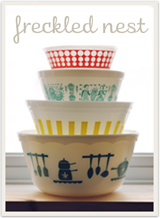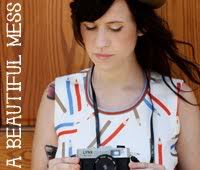I had never heard of her before since usually I just look at the clothing lines and don't study the designers.
What really caught my attention is that she started the trend of ballet flats for day and evening wear, because of the rationing of leather during WWII. Canvas flats are definitely my favorite type of shoes and I have Claire McCardell to thank for that.
She's so inspiring, an article was written about her in Time magazine in May,1955. Here's an excerpt:
"The person who understands best how American women want to look is a shy Manhattan designer named Claire McCardell. Says she: "Clothes may make the woman, but the woman can also make the clothes. When a dress runs away with the woman, it's a horror." Designer McCardell speaks with authority, for she started the casual American Look. Even among fashion editors, who genuflect to Paris before every deadline, she is considered unique. "Claire started the feeling for Americana," says Vogue's Babs Simpson. Agrees Diana Vreeland of Harper's Bazaar: "She gave the American woman a look of her own, and she did it without outside pressures."
Claire McCardell's creations are dedicated to the propositions that 1) clothes should be made to be worn in comfort, and 2) only comfort can create sense-making style. Her clothes are functional, simple and clean of line. She likes "buttons that button and bows that tie." She is, says Dallas Retailer Stanley Marcus, "the master of the line, never the slave of the sequin. She is one of the few creative designers this country has ever produced."
Salads & Mambos. Making clothes with the American Look is no simple trick. U.S. women, says President Hector Escobosa of San Francisco's I. Magnin, "don't want their sports clothes to look like overalls, but they want them to act like overalls." While Claire McCardell and other top designers lead the way, the U.S. fashion industry is now busy turning out garments to keep up with the fast modern pace—dresses that are as at home in the front seat of a station wagon as in the back seat of a Rolls, as comfortable in the vestibule of a motel as in the lobby of the Waldorf, as fitting for work in the office as for cocktails and dinner with the boss. Most of all, they must be practical. Sports clothes must swing as easily on the laundry line as on the golf course, and evening clothes must be designed as much for tossing a salad as treading a mambo.
The American Look has had its influence abroad, particularly in Italy, where it has profoundly influenced the designers of sportswear. Paris has also tried its hand at the style, believing, as Christian Dior said, that la mode sport in America is "beyond doubt excellent." ...
The iconic "popover dress"
...No one on Seventh Avenue is more aware of the tremendous risks in fashion than Claire McCardell, who with her company has had more ups and downs than the hemline. But no one seems less concerned about the rumors, or less worried about where whim will carry fashion next. Says she: "I've always designed things I needed myself. It just turns out that other people need them, too." At 50, Designer McCardell is still her own best model. She is 5 ft. 7 in. tall, has a trim figure (130 lbs.), honey-blonde hair and sparkling blue eyes.
To Designer McCardell, garments must have a reason. After shivering on shipboard during a transatlantic trip in a flimsy, French-designed evening wrap she turned out a wrap in tweed. She went skiing, got cold ears, did a wool-jersey hood. After lugging a trunk and five suitcases around Europe, she decided to save space by making dresses in parts, switching the pieces around for variety—a bare top and covered-up top, for example, to be worn alternately with shorts, slacks or short or long skirts. That was one of the fashion world's first important experiments with "separates," now a mainstay of American sportswear design.
Rivets & Diapers. The list of McCardell firsts stretches back 20 years. She was the first to modernize the dirndl skirt (1938) and the first to use trouser pockets and pleats in women's clothes (1938). She was the first with the widely copied "Monastic" dress, a full and shapeless forerunner of the pleated Grecian sheath and all the other unwaisted dresses. It seemed to have no form. But when it was belted on, it did great things for the female figure. It was McCardell who first started using blue-jean stitching for design in rough denims (1943), and she was the first with the "riveted look," using work-clothes grippers for fasteners and ornamentation. She introduced the "diaper" bathing suit —and in 1942 she started the craze for ballet slippers. Necessity mothered that invention: unable because of wartime shortages to get the proper shoes for her showroom models, McCardell put them all in fabric Capezio ballet slippers. The fad caught on, and she still suggests designs for many Capezio shoes.
While McCardell styles are simple, they can be identified by such things as spaghetti-like ties, big brass hooks and eyes, and a daring use of color. In her 1955 summer line, brick-red shorts are made to be worn with a long-sleeved orange blouse ; a boxy, pullover beach shirt is done in orange and hot pink. There is a Persian crushed-cotton dress of turquoise, moss green, red and chartreuse, and a straight-from-the-shoulder swim dress of brass-colored cotton with an orange tie at the neck.
Above all, Claire McCardell designs are so functional that they stay in fashion; her basic designs, in fact, change but slightly from year to year. Two years ago Los Angeles Art Dealer Frank Perls decided that her clothes were so unique that he collected 20 years of McCardell fashions and put them on exhibition in his gallery. Recently Designer McCardell got a fan letter from a customer who bought a red wool McCardell dress, size 16, for $40 in 1948. It was altered to a size 12 in 1949, re-altered to a size 18 to take care of added weight in 1951, re-altered to a size 12 and then to a 16 again in 1952, and back to a 12 in 1953. It landed in the wash by mistake, suffered "considerable shrinkage," was cleaned several times, taken apart, stretched, pulled and realigned into a size 10. Last year a bottle of hair-tinting shampoo was spilled all over the dress. The owner's report for spring 1955: "Dress is navy blue with silver buttons, fits perfectly; fabric is as handsome as ever, the styling as chic as ever—and [it] draws comments from people all the time!""
Bathing suits images found Here
In closing, I salute you Claire McCardell, for designing my favorite vintage styles and making clothing comfortable. I don't know what I would do if I had to wear a corset everyday. Shallow breathing I suppose..
~Rachael~

































What a gorgeous post! I love your blog - it's so lovely!
ReplyDeleteHave a great day!
Love
Aimee
x
Hello again Rachael. Thanks for commenting on my blog too! Of course I would love you to put my widget on here - that would be great! Thanks so much! x
ReplyDeleteI am pretty sure I have that red dress pattern. I am sure it is still in a box in the garage since we moved. I love her designs. She is also one of my favorites. :)
ReplyDelete-Alicia